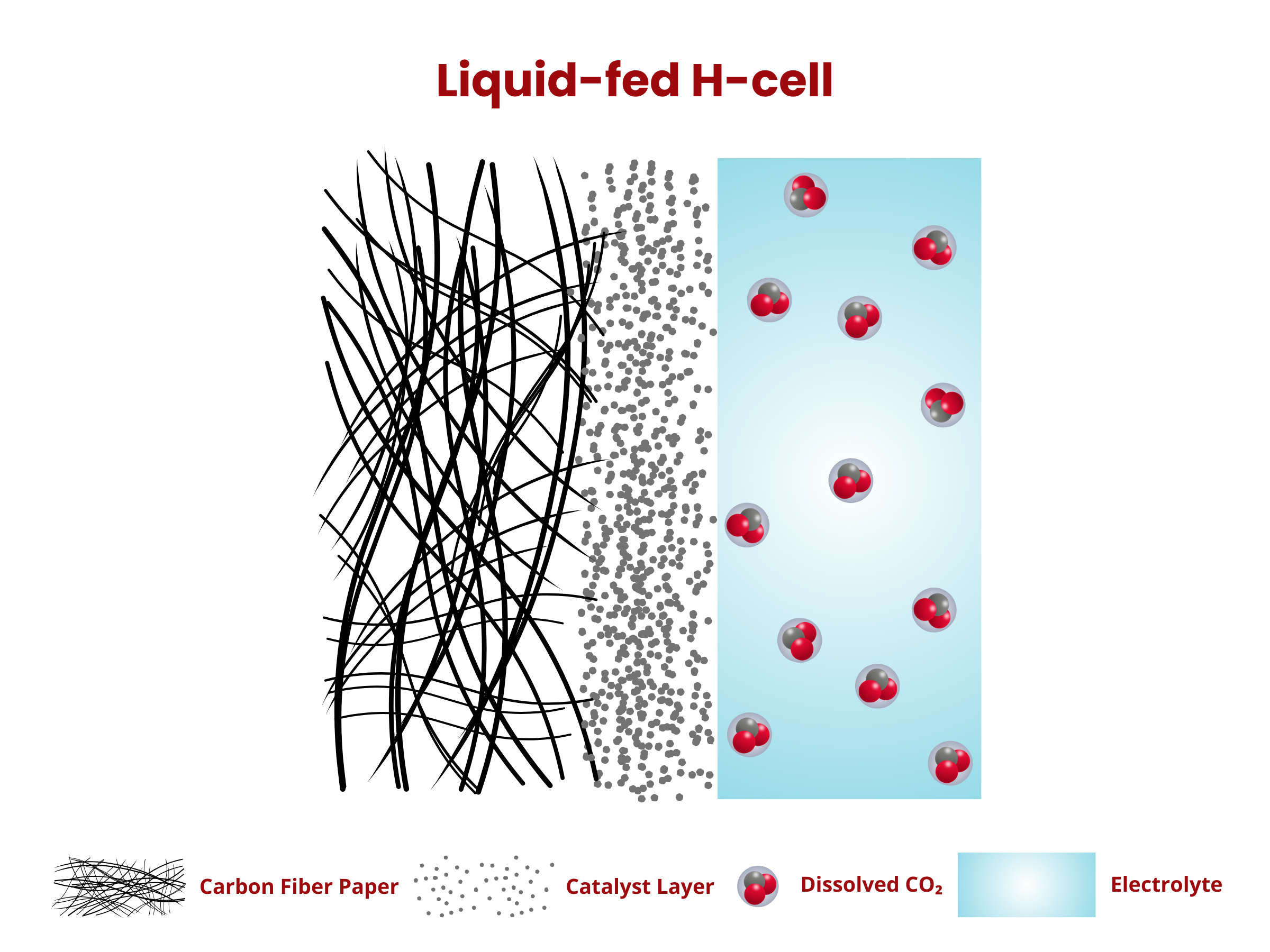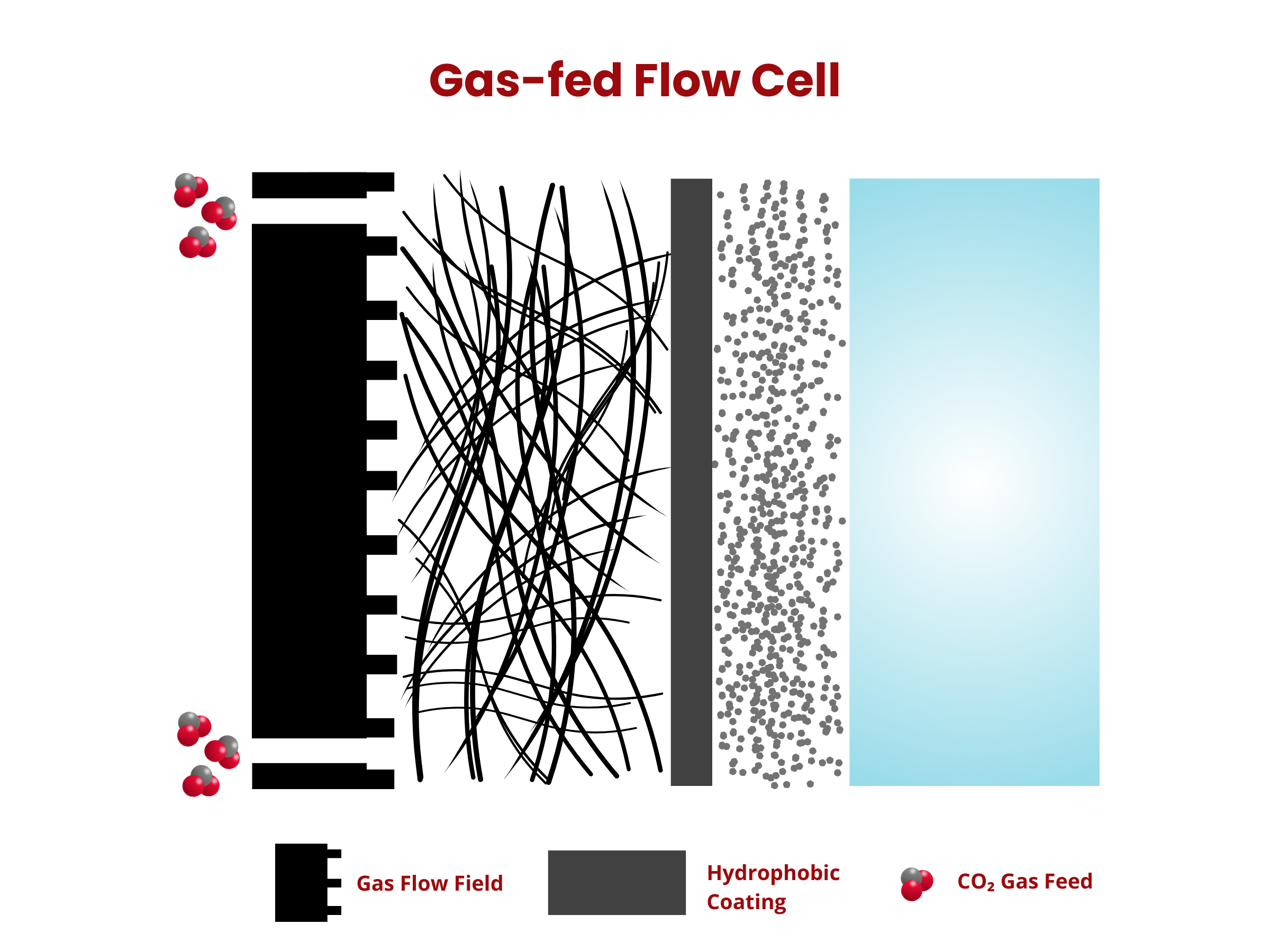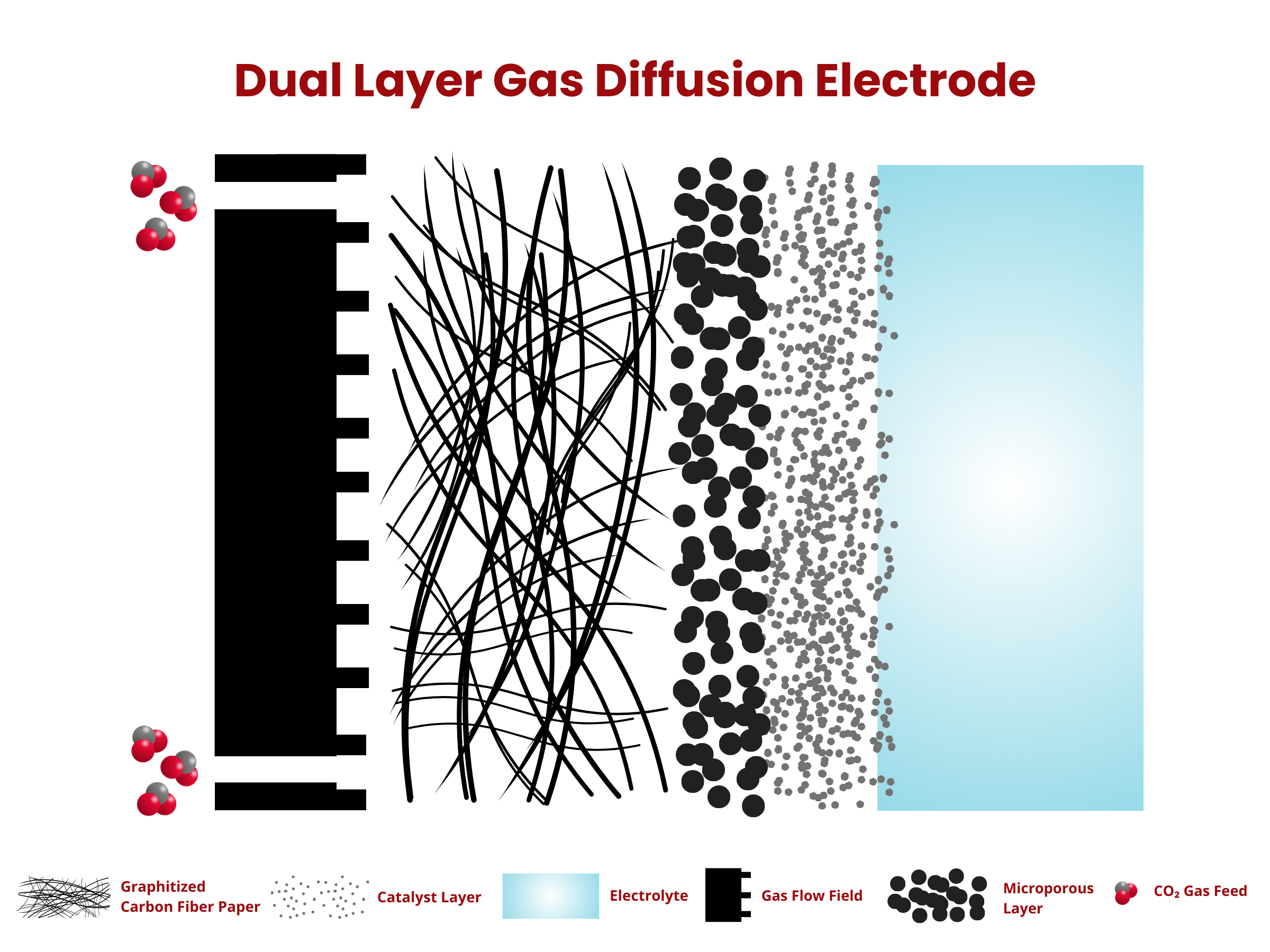Gas Diffusion Electrodes for CO₂ Electrolysis
Gas diffusion electrodes for gas-fed carbon dioxide electrolysis cells
H-cells are often used for the laboratory-scale performance evaluation of carbon dioxide electrolysis components. In this configuration, the cathode, where the carbon dioxide reduction reaction (CO2RR) occurs, is immersed in a liquid electrolyte. CO2, which is dissolved into the electrolyte, must diffuse to the catalyst surface for the reaction to take place. H-cells are known to be effective for low-current density applications. However, the low solubility and slow diffusion of CO2 limits its mass transport towards the catalyst surface, particularly during high-current density operations.

To address mass transport limitations, flow cells have been developed in which CO2 is transported in the gaseous phase. This is made possible through the utilization of gas diffusion electrodes. A gas diffusion electrode (GDE) is composed of a gas diffusion layer (GDL) and catalyst layer. The electrolyte is in contact with the catalyst surface, and the CO2 gas feed diffuses through the GDL. This reduces the diffusion length of CO2 to the catalyst surface, which allows the flow cell to achieve higher current densities than those of H-cells.

Gas diffusion layers for gas diffusion electrodes
In flow cells, the gas diffusion layers (GDLs) of GDEs are porous structures placed in between the gas flow field and the catalyst layer. GDLs perform two primary functions– they allow the diffusion of the gaseous feed to the active material surface, and provide mechanical support to the catalyst layer. They may be composed of a single layer or two layers. Single-layer GDLs are only composed of a macroporous substrate (MPS), whereas dual-layer GDLs contain a microporous layer (MPL) on top of the MPS. Between the two types, dual-layer GDLs are more commonly used because of the hydrophobic nature of the MPL. GDLs need to be hydrophobic to prevent the blockage of their pores with the electrolyte and facilitate gas transport more efficiently.
Graphitized carbon paper in gas diffusion electrodes
Carbon-based materials, such as carbon cloth, carbon felt, and graphitized carbon fiber paper, are the most commonly used MPS for CO2 electrolysis GDEs owing to their high conductivity, excellent stability in acidic environments, good compressibility, and tunable porosity. The typical thickness of carbon MPS for CO2 electrolysers range from 100 to 500 μm.
LINQCELLTM Carbon Cloth for Carbon Dioxide Electrolysis Gas Diffusion Electrodes
| Gas Diffusion Layer Product | Type | Thickness (micron) | Basic Weight (g/m²) | Specific Surface Area (BET) (m²/g) | Benzene Adsorption (weight %) | Iodine Adsorption (mg/g) | Electrical Resistivity (Ω-cm) |
|---|---|---|---|---|---|---|---|
| LINQCELL CF350 | Fabric | 350 | 135 | 2500 | 65 | 2050 | 2 |
| LINQCELL CF400-MP | Fabric | 400 | 135 | 2500 | 65 | 2050 | 2 |
Among these carbon materials, graphitized carbon fiber paper (often graphitized >2000 °C) is widely used in carbon dioxide electrolysis cells. Graphitized carbon paper offers improved conductivity, better compressive strength, and higher chemical resistance than that of ungraphitized carbon MPS. Learn more about the effects of graphitization on carbon fiber paper properties here.
LINQCELLTM Graphitized Carbon Paper for Carbon Dioxide Electrolysis Gas Diffusion Electrodes
Materials Properties | Unit | Method | ||||
Basic Parameters | ||||||
Basis Weight | g/m2 | ASTM D-646 | 50 | 50 | 90 | 90 |
Thickness | mm | TECLOCK SM-114 | 0.18 | 0.21 | 0.21 | 0.24 |
Mechanical Properties | ||||||
Compression Rate @100 kPa | % | - | - | - | - | |
Tensile Strength (MD/XD) | N/cm | ASTM D-828 | 25/18 | 2/1 | 27/- | 30/18 |
Flexural Modulus (MD/XD) | MPa | ASTM D-790 | 3300/1500 | - | - | 4000/1500 |
Gas Transport | ||||||
Air permeability | sec | Gurley | <10 | <3 | - | <85 |
Porosity | % | Mercury Intrusion Porosimeter | 77 | - | - | - |
Electrical Properties | ||||||
TP Resistance | mΩ cm2 | ASTM C-611 | <7 | <10 | 6.5 | <15 |
Voltage Loss | mV | @500mA/cm2 and 20N/cm2 | - | <15 | 14 | - |
With MPL+PTFE Treatment | NO | NO | YES | YES | ||
For single-layer GDLs that only contain MPS, hydrophobicity may be imparted by lowering the surface energy of the GDL using hydrophobic additives or coatings, such as polytetrafluoroethylene (PTFE) and polyvinylidene fluoride (PVDF). However, optimum balance must be maintained as the hydrophobic coating tends to reduce the gas permeability and conductivity of the GDL.
Dual-layer GDLs contain MPS and MPL. MPL is a thin layer composed of carbon nanoparticles coated with the hydrophobic agent, typically PTFE. The MPL primarily improves water management. Additionally, the carbon nanoparticles in the MPL reduce the contact resistance between the carbon-based MPS (graphitized carbon paper) and the catalyst layer, which improves the conductivity of the GDE.


